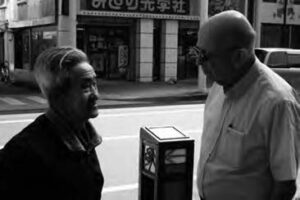Reviewed by David Huebner
More About Mizusawa is the sequel to the critically acclaimed Can’t Go Native (2010), a personalized, anthropological history of Japan. Featuring the lifelong work of American anthropologist Keith Brown in northern Japan, this second DVD delivers the details and delights of ancient Japan and the connections to Japan’s modern culture.

Most of the film takes place in a Japanese home, as Dr. Brown is interviewed by various American experts—no doubt well-heeled in Japanese culture and history. These include “Samurai History” and “Mizusawa in Japan’s History” with Ronald Toby, “Everyday Buddhism” with Brian Ruppert, “Is There Life After High School?” with David Plath, and “Can’t Go Naked?” with Jacquetta Hill.
Although the West has distorted samurai into mere warriors, their true heritage reveals people rich in knowledge of mathematics, reading, writing, religion, and ritual. The grip of the samurai is so strong that 25 percent of current descendants in Mizusawa live on the same property as samurai ancestors from the 1820s, and many of the ancient traditions are still observed, even down to what door to enter a home! As Dr. Brown asserts, “The past is very much alive in the social relations.”
Only 250 miles north of Tokyo, Mizusawa was not truly connected to the rest of Japan until the ninth century. Peopled by the Emishi, now absorbed into Japan’s long history, this region was once considered the “Tibet” of Japan: distinct, unique, and with traditions and heroes that have enriched all of Japan.
Most of the world is challenged to understand the unique combination and characteristics of Buddhism and Shintoism. Those who grow up in Japan “get it” (it’s hard to “go native” in Japan), while most of us struggle to understand how a Shinto shrine can share space with a Buddhist temple. Yet commitment to religious tolerance is so strong that, unlike some parts of the world, Japanese don’t “kill each other over religious differences.”
In a warm and refreshing twist in the film, we discover the “secrets” to Brown’s success as an anthropologist: social butterfly in high school, successful athlete and musician, and an obvious ability to “talk to everybody.”
A rich discussion of the adjustments Brown’s wife, Ruth, and their three children made while living in Japan in the 1960s ensues. We find that this anthropologist manifests well the art of great fieldwork and research: “Community carries people!” Because of the interplay between the experts and the subject content in More About Mizusawa, this film is suitable and, indeed, intriguing for high school or college students. Brown richly deserves the Imperial Award Certificate for his responsible decades of work and community with the people of Mizusawa and the legacy he leaves in understanding Japan.

